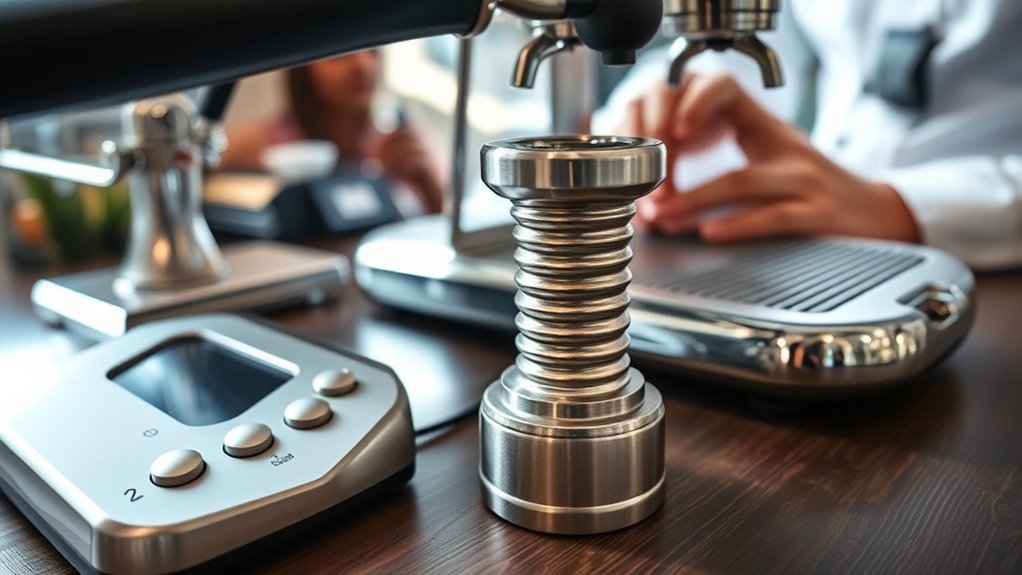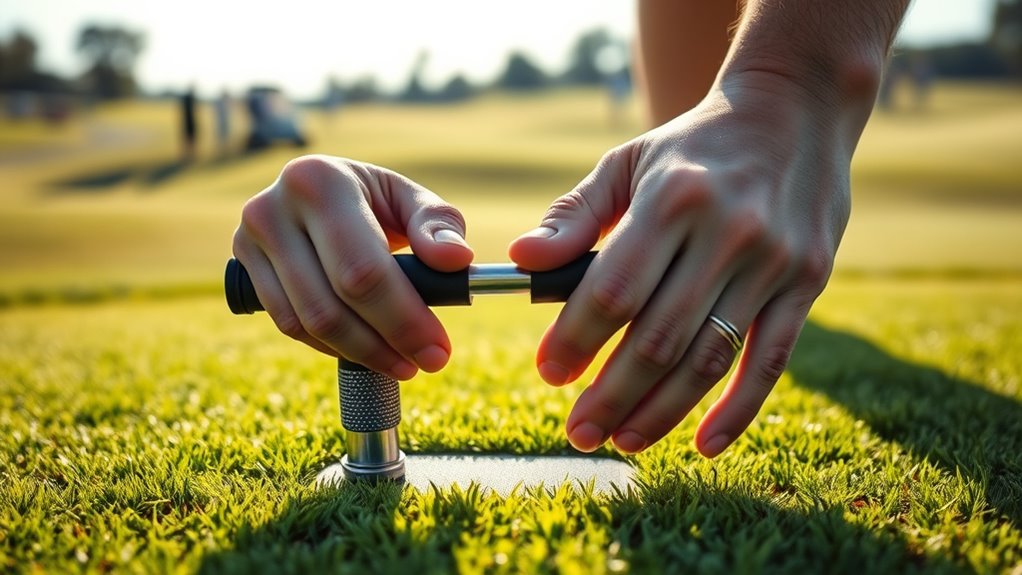Before revisiting tamping pressure basics, you need to honestly evaluate your current experience and confidence levels. Check your equipment’s condition and calibration, ensuring everything is working properly. Review your past tamping sessions to spot mistakes or inconsistencies, and set clear goals to guide your improvements. By understanding your strengths and areas needing focus, you’ll optimize your approach and achieve better results. Keep exploring to discover more about fine-tuning your technique and equipment.
Key Takeaways
- Honestly assess your current tamping experience and comfort level to identify areas needing improvement.
- Review fundamental principles of soil compaction and ensure your equipment is properly calibrated.
- Inspect and maintain your tamping tools to prevent malfunctions and ensure consistent force application.
- Revisit your project goals and set clear, measurable objectives to align your technique with desired results.
- Analyze previous tamping sessions to recognize patterns, mistakes, and areas for technical refinement.
Assess Your Current Experience Level

Before adjusting your tamping pressure, it’s important to honestly assess your current experience level. This skill assessment helps you understand where you stand and what improvements are needed. Take a moment to evaluate your familiarity with tamping techniques and the results you’ve achieved so far. Are you comfortable applying consistent pressure, or do you often find yourself unsure? Your experience evaluation guides your approach and prevents unnecessary adjustments. Recognize your strengths and identify areas where you lack confidence or consistency. Being sincere about your skill level ensures you don’t overcompensate or underperform. Understanding asset division principles can further inform you about fair treatment and potential adjustments in your technique. This clarity allows you to set realistic goals and focus on refining your technique, ultimately making your tamping more effective and precise.
Review Fundamental Tamping Principles

Understanding the fundamental principles of tamping is essential for achieving consistent and effective results. At its core, soil compaction depends on applying the right amount of pressure to eliminate air gaps and increase density. Proper tamping techniques guarantee the soil reaches ideal compaction levels, which improves stability and durability. Equipment calibration plays a crucial role here—if your tools aren’t properly calibrated, your tamping pressure may be inconsistent, leading to uneven soil density. Always verify that your tamping equipment is correctly calibrated before starting work, so you can trust the force you’re applying. Mastering these principles ensures you deliver uniform tamping pressure, resulting in better soil compaction and a stronger foundation for your project. Focusing on mindfulness techniques can help maintain concentration and precision during tamping, ensuring consistent results. Focus on these basics to improve your overall tamping effectiveness.
Check Your Equipment and Setup

Ensuring your tamping equipment is properly checked and set up is vital for consistent results. Regular equipment maintenance keeps your tools in top shape, preventing malfunctions that could affect tamping pressure. Before each session, inspect your tamper for wear and damage, and tighten any loose parts. Make setup adjustments to guarantee your tamper is aligned correctly and functioning smoothly. Proper calibration of your equipment helps maintain uniformity in tamping, which is essential for achieving optimal soil compaction. Paying attention to equipment calibration ensures each tamp delivers the right force consistently. Don’t overlook small details—an improperly set-up tamper can lead to inconsistent results and increased effort. Taking a few minutes to verify your equipment and fine-tune setup adjustments saves time and improves overall performance, giving you confidence in every tamp.
Revisit Your Goals and Expectations

Take a moment to revisit your tamping goals and make sure they still align with your overall expectations. Clear goals help you measure progress and make adjustments as needed. When your expectations are set, you’ll find it easier to stay consistent and improve your results. Additionally, understanding the cookie categories involved in tracking your progress can help you manage your privacy preferences effectively.
Align Your Tamping Goals
Have you ever paused to revisit your tamping goals and expectations? Aligning these goals helps you focus on technique refinement and proper equipment calibration. When you clarify what you want to achieve, whether consistency or speed, it becomes easier to adjust your approach. Take time to evaluate how your current method performs and whether your equipment is calibrated correctly. Proper calibration ensures you apply the right pressure and tamping depth, aligning with your goals. This Proper calibration is crucial for consistent results and optimizing your tamping process. This alignment keeps you on track and prevents unnecessary adjustments later. Consistently revisiting your goals helps you stay focused on improving specific aspects of your tamping process, ensuring your efforts are purposeful and effective. Clear goals lead to more deliberate practice and better results over time.
Set Clear Expectations
Revisiting your tamping goals is the first step toward setting clear expectations for your process. Knowing what you want to achieve helps you focus on refining tamping techniques and ensuring equipment calibration is accurate. When you revisit your goals, consider the desired consistency, shot quality, and machine performance. Clarify these expectations before adjusting pressure or techniques, so you can measure progress effectively. Additionally, understanding the *best* anime movies can inspire you to approach your goals with a fresh perspective and motivation.
Observe and Analyze Past Tamping Sessions

By carefully observing and analyzing past tamping sessions, you can identify patterns and pinpoint areas where your technique may need improvement. Watch how you apply tamping techniques, noting any inconsistencies or mistakes. Pay attention to how evenly you distribute pressure, the depth you achieve, and your rhythm. Also, review your equipment maintenance habits—cleaning, lubrication, and calibration—to guarantee your tools function at their best. Recognizing recurring issues helps you understand what’s working and what isn’t. This analysis allows you to make informed adjustments, ultimately improving your overall tamping performance. Systematic review of previous sessions enhances your understanding of tamping pressure and helps develop more effective strategies. By systematically reviewing your previous sessions, you gain insight into your habits, guiding you toward more effective, consistent tamping results.
Identify Specific Areas for Improvement

To improve your tamping pressure, you need to pinpoint specific areas where your technique falls short. Recognizing these gaps allows for targeted technique refinement and guarantees your equipment is properly calibrated. Focus on how you apply pressure, your stance, and your rhythm. Are you consistently applying enough force? Is your tamping motion smooth and controlled? Check if your equipment calibration is accurate—improper calibration can lead to inconsistent results. Additionally, understanding proper technique refinement can significantly enhance your performance.
- Assess your hand positioning and body mechanics
- Observe if your tamping force varies across sessions
- Verify that your tamping tool is calibrated correctly
- Track whether your technique improves with practice over time
Frequently Asked Questions
How Often Should I Recalibrate My Tamping Pressure?
You should recalibrate your tamping pressure whenever you notice inconsistencies in your dose calibration or if your tamping tools show signs of wear. Regularly check your equipment at least once a month to guarantee accuracy. If you switch tamping tools or change your coffee grind, recalibrate immediately. Consistent recalibration helps maintain ideal extraction and flavor, so stay attentive to your equipment’s performance and make adjustments as needed.
What Are Common Signs of Incorrect Tamping Pressure?
Incorrect tamping pressure often causes uneven distribution uniformity, leading to inconsistent results. You might notice your tamping technique feels too forceful or too gentle, resulting in loose or overly compacted soil. Signs include surface cracks, shifting of the material, or poor compaction. If these issues appear, it’s time to reassess your tamping pressure to make sure you’re applying the right force for ideal results and a stable, even surface.
Can Tamping Pressure Affect Espresso Flavor Significantly?
Yes, tamping pressure can profoundly affect your espresso flavor. If you apply too much pressure, it may cause over-extraction, making your shot bitter. Too little pressure results in under-extraction, leading to a weak taste. Adjusting grind size and maintaining consistent brew temperature also influence flavor. Proper tamping ensures even extraction, highlighting the right balance of acidity and sweetness. Focus on consistent pressure to improve your espresso’s overall taste.
How Do Environmental Factors Influence Tamping Consistency?
Environmental effects can shake up your tamping stability, making consistency a real challenge. Humidity, temperature, and airflow influence how evenly you press and pack the coffee. When these factors are out of whack, your tamping can become a wild card, leading to uneven extraction. To keep your game tight, control your environment as much as possible—think of it as keeping everything on an even keel—so your tamping stays precise every time.
What Advanced Techniques Can Improve My Tamping Pressure Control?
To improve your tamping pressure control, focus on fine-tuning grind size adjustments to guarantee consistent extraction. Use a scale to maintain dose consistency, which helps stabilize tamping force. Practice applying even, firm pressure in a controlled manner, and experiment with slight variations to find what works best. Incorporate these advanced techniques regularly, and you’ll develop a more precise, repeatable tamping process that enhances your espresso quality.
Conclusion
By taking these steps, you’ll sharpen your tamping skills and avoid repeating past missteps. Think of it like tending a vintage garden tool—regular care keeps it sharp and ready. Remember, progress comes with patience and practice, just like waiting for that perfect cup of coffee to brew. So, before you dive back into tamping pressure, pause, reflect, and prepare—your future self will thank you, just like a knight appreciating a well-forged sword.









